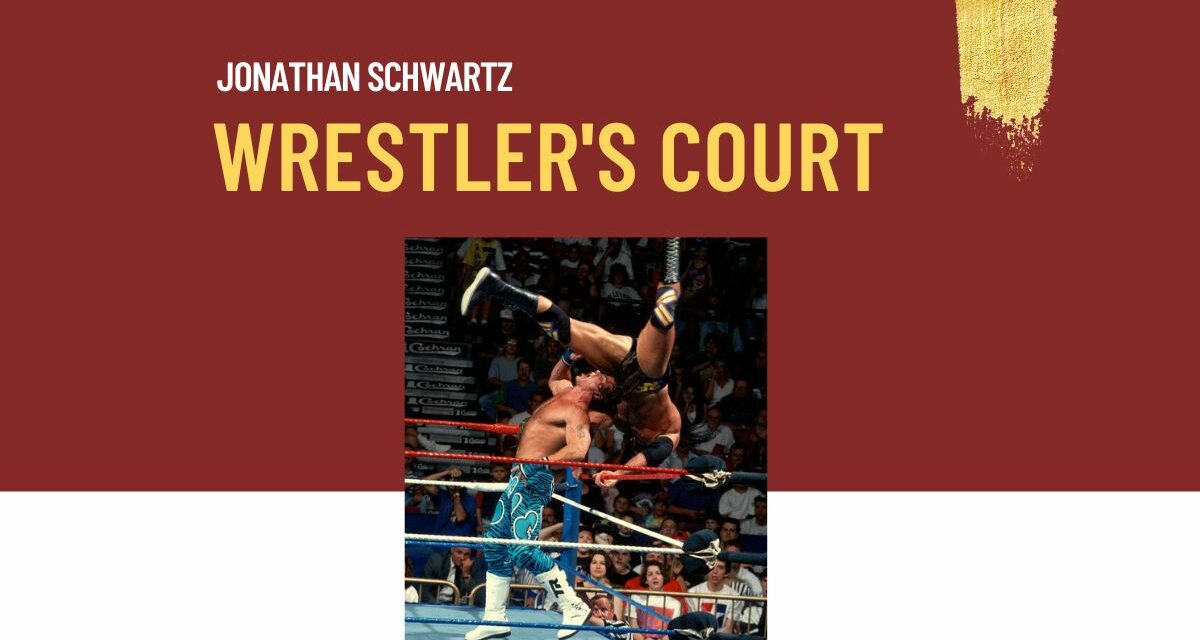On July 1, 2023 (Canada Day!) WWE will present the 14th iteration of its Money in the Bank Premium Live Event, the focus of which is presumptively the pair of multi-person ladder matches after which the show is named.
I say ‘presumptively’ because the actual Money in the Bank (MITB) ladder matches don’t feel like the focus of this year’s show and haven’t felt important for a few years.
Forgive my uncharacteristically salty response, but I think it’s time to rename the event and end these potentially dangerous matches, since the risk doesn’t justify the reward.
First, some background:
Between the historical rigor of kayfabe and the possibility of independent invention in a pre-internet territory system, I take wrestling history with a mine of salt. That said, conventional wisdom has it that the ladder match was invented in Calgary in 1972. There are competing claims between Stampede Wrestling historians as to its actual inventor. Dan Kroffat is generally credited, though Bruce Hart has claimed the idea was his. But then, Bruce Hart claims most good ideas are his. British wrestler Kendo Nagasaki is also in this conversation, although his first recorded ladder match seems to have taken place years later, in 1987.
The first ladder match to gain prominence was a July1983 Stampede tilt between Bret Hart and Bad News Allen. Bret left Stampede in 1984 for the then-WWF and claims that he suggested the match to Vince McMahon in the early 1990s. Bret would face Shawn Michaels in the first WWE ladder match for the Intercontinental Championship in 1992, taped for a home video release. The stipulation wouldn’t take off until Michaels fought Razor Ramon for that title at WrestleMania X in 1994. Since then the match and its permutations have been a frequent part of WWE programming. House show programs aside, WWE has held almost 75 televised ladder matches for stakes as varied as titles, careers, and most recently a bag of money that Dexter Lumis took from The Miz.
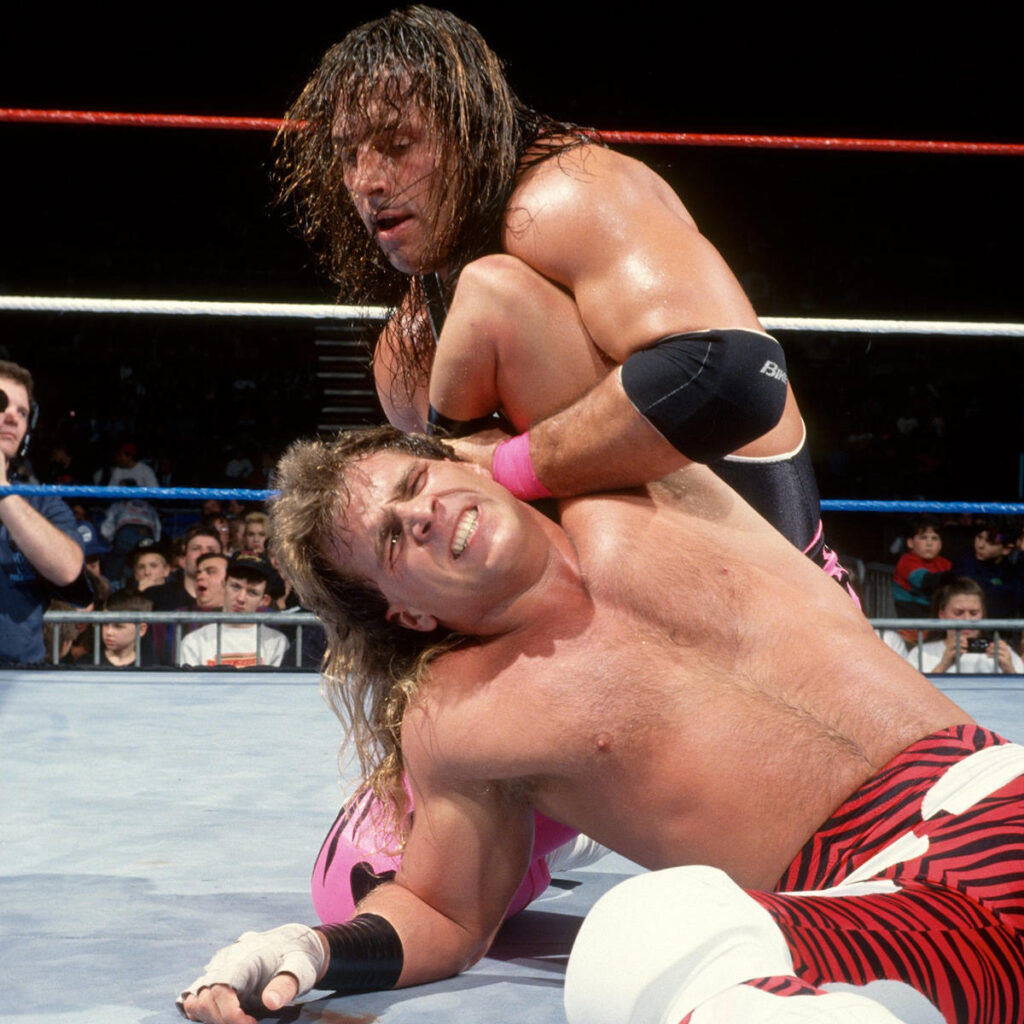
Shawn Michaels vs Bret The Hitman Hart. Photo courtesy WWE.com
This number does not include the MITB match, which is attributed to Chris Jericho. Seeing the popularity of standard single and tag team ladder matches, Jericho suggested expanding the format to an “every man (and later woman) for herself” type match, with a title shot to be used at the winner’s discretion as the prize. The first MITB match took place in 2005 at WrestleMania 21. Edge would win the briefcase and held onto it until January 2006, when he beat John Cena for his first WWE Championship. Edge’s victory established the idea that the title shot could be ‘cashed in’ under any circumstance, giving a dastardly heel license to score a cheap title victory over an incapacitated babyface. It also launched Edge as a main event heel, where he spent most of the rest of his career.
For years, MITB provided a great storytelling device. In 2006 Rob Van Dam would win and call his shot against John Cena at the Extreme Rules pay-per-view. Van Dam’s title run would be curtailed for other reasons. Mr. Kennedy would win in 2007 (more on him, and Edge’s eventual cash-in with his briefcase later). CM Punk went back-to-back in 2008 and 2009, the latter win igniting a heel championship run.
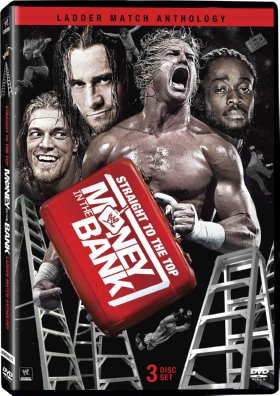
The Money in the Bank DVD
Jack Swagger would follow in 2010, winning MITB and beating beating Chris Jericho for the World Championship on an episode of SmackDown shortly thereafter. Swagger’s win made sense at the time; he was a heavily pushed young talent who had already held WWE’s version of the ECW title, but he would have one of the first undistinguished post-MITB runs.
Over the next few years, things would get murky. MITB would move to its own pay per view in 2010, removing a hot WrestleMania opener before a rabid crowd and replacing it as a gimmick main event in its own right-like the Royal Rumble or Survivor Series matches. Depending on the state of the brand split, MITB would be watered down further. Some years would feature more entrants than others. Sometimes there would be two ladder matches on the same card, one for each title (or not, since winners would occasionally swap brands to take advantage of a downed champion).
The lack of narrative consistency that affects much of WWE’s programming would hit MITB too. Winners included everyone from Kane and the Miz (he comes up here a lot) to Alberto del Rio and Daniel Bryan to John Cena and Dolph Ziggler. Seth Rollins’ victory in 2014 produced a WrestleMania highlight. Dean Ambrose’s win in 2016 attempted to capitalize on his anti-authority popularity but never quite hit the mark. Ambrose’s win makes for a neat trivia question, since he cashed in on former Shield teammate Rollins, who had just beaten former Shield teammate Roman Reigns for the title, all at the same event.
More recently, winners seem to be chosen without direction. Baron Corbin won in June 2017. A tall, sneaky, rangy heel he would have been a good choice for a prolonged chase. Instead, he tried to cash in by August against fellow heel Jinder Mahal, who was in the middle of his own poorly-received title reign (I liked Mahal as champion and always thought he deserved another go). Worse, John Cena cost Corbin his shot. In a fit of nonsensical booking, Corbin was undermined by a good guy helping one bad guy beat another bad guy. This made the whole thing feel anticlimactic and helped neither Corbin nor Mahal’s careers.
The last several years have strayed from the match’s conceit as a test of mid-carders main event prospects. Inserting multiple repeat former WWE champions diminished the unpredictability of the match. It was exciting when the likes of Edge and Rob Van Dam and CM Punk and Dolph Ziggler won. Fans could see whether these men (and later women) could hang with established talent. Even better if a title win launched them to bigger and better things. WWE’s more recent holding pattern with its championships made MITB feel much less special. A victory felt less special when John Cena or Randy Orton or Kane or Sheamus attempt to cash in for their nth reigns, especially at the expense of fresh champions.
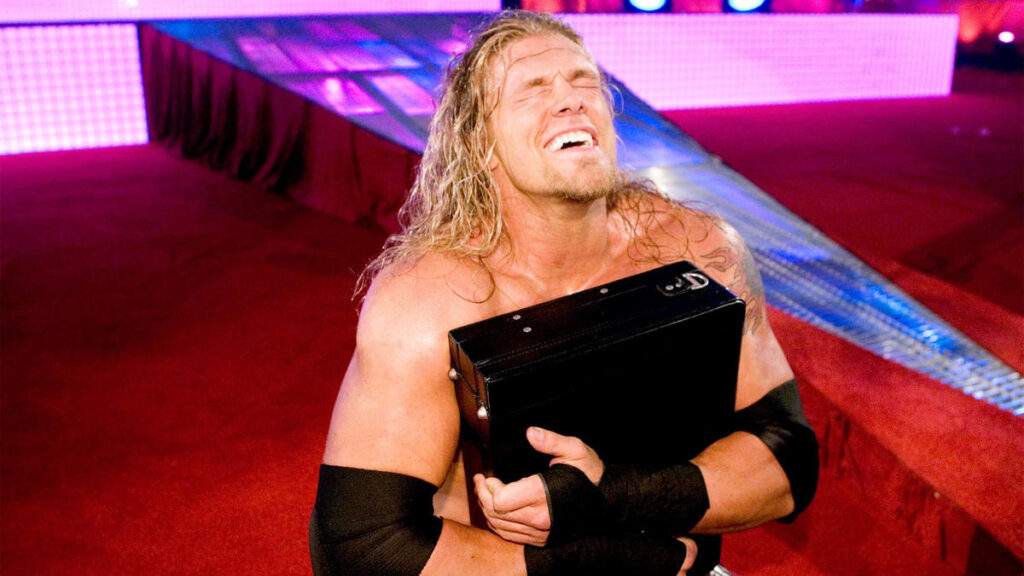
Edge wins MITB. Photo courtesy WWE.com
WWE ignores its own rules and continuity as it suits them. In 2019 Brock Lesnar, whom you think would be the last person in WWE to need a McGuffin to win a belt, took out Sami Zayn and won the briefcase without actually being part of the match. He would go on to clown around with the briefcase for months, adding stickers that made it look like a boombox and dancing the ‘Running Man’ while Paul Heyman cut promos. Lesnar would cash in on SmackDown’s first night on the FOX Network, bringing an inglorious end to Kofi Kingston’s KofiMania championship run. Maybe WWE thought this would help cement SmackDown as destination TV but long-time fans groaned at the rehash, and felt bad for Kingston, who would return to the tag team ranks without so much as a peep.
I think the bloom fell off the MITB rose in 2020, when Otis won a cinematic version of the match that saw contestants engage in a Tex Avery cartoon fight to the roof of Titan Towers where a ring was set up with the usual ladder and briefcase.
I give WWE a pass for much of their pandemic-era programming. In truth, I was glad for the distraction but this match was silly from beginning to end. I don’t like ‘death’ angles for a bunch of reasons, and here at the height of COVID they thought they could throw Rey Mysterio and Alastair (now Malaki) Black off the side of a building and have them emerge unscathed like the Giant off the roof of Cobo Hall. That was a dumb idea when WCW did it 20 years prior. It didn’t improve with age.
To make matters worse, the field for this match was a bit more intriguing than average. As noted I don’t love bringing former champions into these matches but here you had AJ Styles, Black, Daniel Bryan, King Corbin, and Mysterio in the mix, most of whom were solid wrestlers who could actually pull off the occasional daredevil spot. Even Corbin, who had previously won and failed to cash in, had a bit of a backstory and functioned well as the token snarling bad guy who gets to brace stuff.
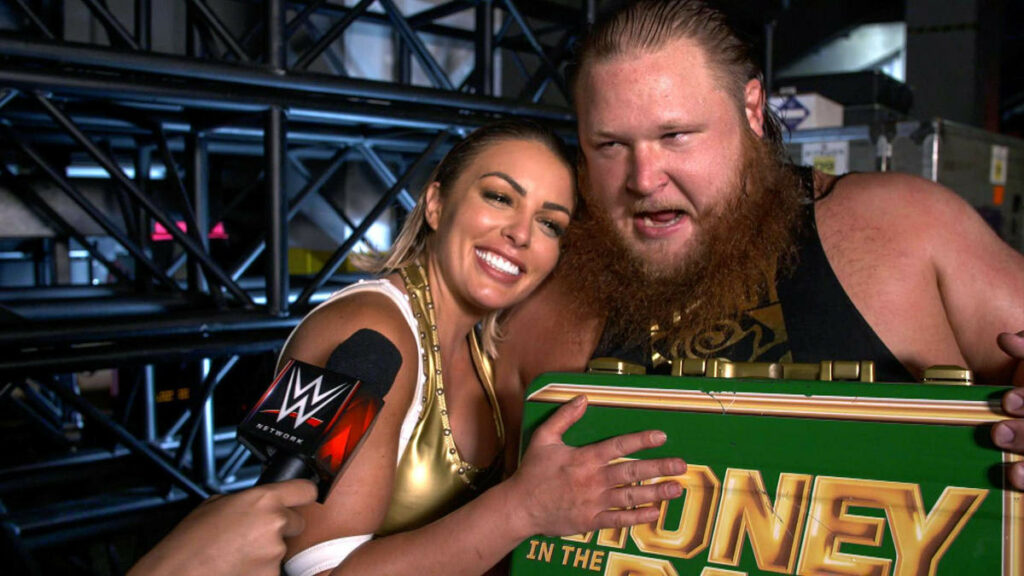
Otis & Mandy Rose. Photo courtesy WWE.com
Instead, we got Otis in the middle of his misguided push as a semi-literate George Steele in lust with Mandy Rose. The briefcase and its potentially life-changing prize didn’t matter to Otis or his story (which would seem to grossly undermine the idea that professional wrestlers are, you know, professional) and it was clear WWE had no plans to advance Otis beyond his position as comic relief. Otis would lose the briefcase after almost 200 aimless days to the Miz, who would cash it in on Drew McIntyre for Raw’s championship within two months. Otis never so much as teased using his opportunity. The Miz showed us how it’s done.
Otis’ loss of his title opportunity wasn’t a first. The third-ever MITB match winner was Mr. Kennedy. Apparently he was supposed to win the WWE Championship at some point, but a combination of injuries, backstage heat and some poor media appearances in the wake of a steroid scandal (which eventually caught up with Kennedy himself) and the Benoit murder-suicide put those plans on ice. Fearing a serious injury that would take Kennedy out of action for a prolonged period of time, WWE arranged a quickie match where he lost the briefcase to Edge in May, 2007. Edge would go on to beat the Undertaker for the World Championship on SmackDown the next night. Turns out Kennedy wasn’t that badly injured after all, but today even he would tell you that WWE likely made the right call.
Last year’s winner, Austin Theory, may have killed the franchise. Theory won the bout in a good enough match, then proceeded to use his briefcase to challenge for the United States championship. Casual and informed fans alike reacted with incredulity. How could Theory, who is seen as a prospective main event player (and whose whole gimmick is based on him being ‘the now’) forego a world title opportunity in favour of a shot at a secondary belt he had previously held? Theory would attempt to justify this decision on a subsequent edition of RAW, arguing that he set his sights lower because he didn’t believe he could beat Roman Reigns, and this year WWE announcers confirmed that secondary titles are in play-though I don’t know who would be stupid enough to follow Theory’s lead.
Let that sink in. Within the rules of the MITB universe, Theory decided that at no time in the next calendar year would Reigns be sufficiently weakened to make him vulnerable-despite the fact that in the buildup to his matches Reigns is often left laying. In recent memory Reigns was beat up by Cody Rhodes, kicked into oblivion by Sami Zayn, jumped on by Kevin Owens and just a few weeks ago ate stereo superkicks from his cousins, the Usos. Here was an opportunity for an epic briefcase moment which would have mitigated the interference Theory and fans might have considered insurmountable. But Theory the character was impatient and settled for less, while WWE writers opted to forego a memorable moment since they couldn’t figure out what to do next.
For context, the Miz might be considered one of the weakest champions ever (I actually love his heel work, but I doubt he’s on anyone’s Mount Rushmore) and he leveraged the briefcase to win both of his championships against stronger opposition: Randy Orton leading to a months-long run and a WrestleMania main event, and Drew McIntyre, which led to a quick transition to Bobby Lashley. Still, it got his name in the record books twice and on the heels of the Iron Sheik’s death, let’s not dismiss transitional champions completely.
Even if Theory failed (and there have now been several failed cash-in attempts), this was a chance to set him up as a brash new challenger in the near to middle term and get his name in the world title conversation. Instead, he relegated himself to the mid-card, proving himself a coward-and an ineffectual one at that since he lost his attempt against then-US champion Seth Rollins on October 10. More perplexing, Theory would win the title six weeks later in a Triple Threat match. If this is how WWE Superstars plan on using a prize won in an inherently dangerous match, why bother?
One of the challenges posed by ladder matches (and gimmick matches in general) is that in order to be compelling, wrestlers have to come up with ever more creative and less safe uses for the plunder. When introduced in Calgary and later in WWE, WCW, ECW, Impact and elsewhere, ladder matches added the novelty of incorporating a foreign object into the match itself.
Ladder matches like those involving Bret Hart, Shawn Michaels and Razor Ramon saw the ladder used mostly, and sparingly, as a weapon. If you watch some of these contests you’ll notice that they often start conventionally. The hardware doesn’t enter the ring until well after the match has started, since logic would suggest you’re better off incapacitating your opponent before you risk ascent. Wrestling ladders can be rickety, so you want to be at least somewhat sure your opponent won’t catch you in a more vulnerable position and tip the ladder over (that part is a mainstay of these matches to this day, especially if the wrestler being tipped lands with the top rope wedged between his or her legs since 1) low blows are next to fatal in pro wrestling, and 2) no wrestler has ever heard of a protective cup). As the match progressed, one wrestler might ram the others’ head into the ladder much the same way as turnbuckles are used, or use the physics-defying power of an Irish whip to propel said wrestler bodily into the ladder. Occasionally a bigger, stronger wrestler might hoist the ladder and use it as a novelty baseball bat or battering ram, or slingshot man into ladder or ladder into man. All of this in service of a final stunt- a swan dive off the top of the ladder, even if that ignores the object of the match, being retrieval of some object just out of the ladder’s reach (briefcase, title belt, Vince Russo’s career).
Early ladder matches served a similar purpose to cage matches. They were used to settle feuds and promote a more creative brand of violence. A traditional ladder match involved placing some disputed totem high above the wrestlers, who would vie for it while taking each other out. It was a literal reach to the top to claim a disputed prize. If pro wrestling works best when it tells simple stories, the ladder match formula was perfect: two wrestlers who couldn’t stand each other, locked in competition over a trophy, willing to do anything to themselves and each other in order to win it. Simple. Brutal. Easy to understand and capable of being executed safely. I wouldn’t want to take a ladder shot to the solar plexus but there’s an element of stagecraft here: the ladders that are typically used are made of lightweight materials like aluminum or plastic. If you’ve ever watched a wrestler struggle to navigate sliding a ladder in or out of a ring or do a tipsy ‘helicopter’ spot to clear the ring of opponents (Terry Funk was the best at this) you can see how unwieldy a ladder can be as a believable cudgel or projectile.
These early contests weren’t specialty matches for the sake of a random prize, which is how they have evolved with MITB, the same way that the Elimination Chamber has undermined the idea of a cage match being to force heated rivals into a confrontation from which there is no escape. I would argue that taking the personal element out of these matches in favor of using the ladder as a tool try to elevate (ha!) a performer above his or her station is where the trouble begins. Without a score to settle a ladder match is simply a race to the top-a fact that ‘chicken’ heels will often use to build heat early. Throw multiple wannabe contenders into the mix and the result owes more to a battle royale, with the same minimal level of fan interest until you get to the few plausible challengers in the lot.
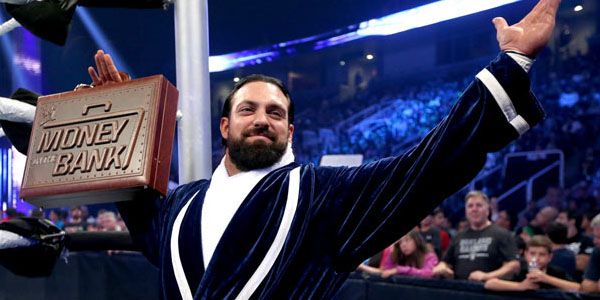
Damian Sandow with his Money in the Bank briefcase. WWE.com photo
To compensate for the predictability of outcomes, WWE has taken to larding its MITB matches with daredevils who execute increasingly acrobatic and risky stunts. I understand that injuries are a part of wrestling. Bryan Danielson just broke his forearm in a standard match against Okada at AEW’s Forbidden Door. Big E Langston (a former MITB winner whom I hope gets another shot with the briefcase) may have lost his career to a poorly-executed belly to belly suplex. Matches like MITB beg for bad outcomes no matter how professional the wrestlers are inside the ring. In 2013 a returning Rob Van Dam suffered a nasty head wound in the match. Randy Orton, Sheamus and CM Punk have also suffered legitimate publicly disclosed injuries. Most recently, one can add Shotzi, who was bloodied in last year’s women’s match. Edge, Christian and the Hardys have also suggested that the impacts involved in these matches hurt them and shortened their careers.
I think that at least for now, ladder matches-especially the MITB version, have run their course. It’s time for WWE to consider either returning them to the opening bout of WrestleMania, where they can contribute to the big-game feel of the event and help set up next year’s meaningful stories, or to do away with concept altogether until an important plot warrants them.
As usual, there’s a precedent. For the better part of 30 years WWE’s Survivor Series has anchored its Fall season. Established as a “Thanksgiving Night Tradition” the original Survivor Series featured five-on-five elimination tag team matches, including one devoted to the roster’s tag team division (which must have made it difficult for fans in attendance to see into the ring) and one for the largely-ignored women’s division. Over the years the formula would be tweaked depending on the roster size and last-minute substitutions due to injury or failed drug tests or contract disputes (journeymen as varied as Scott Casey, Louie Spicolli, Jeff Gaylord and Barry Horowitz made it onto various teams over the years-as did less-famous Hart siblings Keith and Bruce).
The all-tag team bout would fall off swiftly: tag teams would instead be integrated into standard matches, whether four-on-four or five-on-five. Until the Women’s Revolution a few years ago, there were rarely enough female wrestlers to fill a match, and they were usually busy playing subordinate roles to storylines or competing in swimsuit or lingerie contests.
Creative’s attention to these matches would wax and wane over the years.
Done well, they paired off wrestlers in various stages of feuds-blowing off some and creating new dance partners or heightening the anticipation of a new feud where neither combatant had scored a decisive victory. With so many bodies on the ring apron, matches could milk a heel’s refusal to enter the ring or heaven forbid throw hands against their purported opponent. The Survivor Series made a great platform to break out a star in line for a push by feeding them a series of out-of-canon victories over the other team’s members, or to debut new stars like WWE legend (Kane) the Undertaker or WWE jabroni Rocky Maivia.
Done poorly, wrestlers could debut as non-entities, like Mike Knox or Tyler Rex, and the matches themselves would serve as parking lots for disengaged mid-card talent.
There’s been a lot of the latter lately. Even worse, in the wake of various brand splits WWE had turned the whole event into a SmackDown vs. Raw snorefest, featuring the respective brands’ champions fighting each other in non-title matches and the leftover talent stuck in pointless elimination matches for ‘bragging rights’ despite internecine conflicts on each team. I’ve written before about the softness of the brand split, and how its timing often meant RAW and SmackDown’s teams would feature wrestlers who’d only joined their respective rosters weeks earlier. As a former chemistry professor of mine would say, “it just makes no damn sense”.
So, during the Vince Interregnum WWE Head of Creative Paul ‘Triple H’ Levesque did a rare thing in WWE and fixed the problem. He replaced the tired and nonsensical format of traditional Survivor Series matches with the War Games double-ring steel cage match inherited from WCW and most recently featured in NXT. This match wasn’t perfect either-the build-up felt rushed and the women’s team in particular lacked a backstory that would justify using a steel cage, but it was new and different to most of the audience, and for those of us who are old enough to remember the Four Horsemen and Dusty Rhodes and the Road Warriors brutalizing each other, it offered the promise of cathartic violence.
I realize that War Games is as dependent on plunder as MITB but note that in its history War Games has been used to settle top-line feuds, which is where I think most heavy stipulation matches belong. MITB is something different. It should be about creating new main event stars. It’s literally a golden ticket to a championship match. Used judiciously, it creates a sense of anticipation when as to when the winner (especially a heel like Edge or Rollins or The Miz) will cash in and disrupt a good guy’s title reign, giving rise to the next chase that fuels our interest as fans.
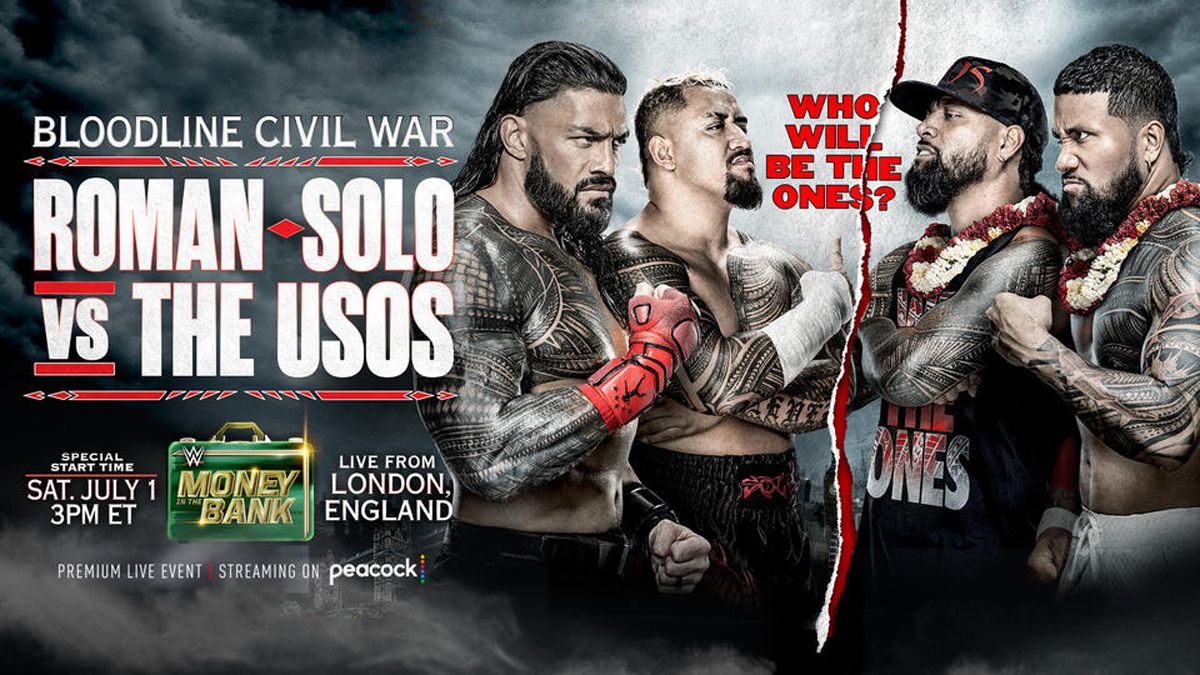
This year’s ladder match feels like a backdrop for the developing Bloodline feud, which will see Roman Reigns team with Solo Sikoa against Sikoa’s brothers, the Usos. MITB 2023 has a regrettable also-ran quality to it with the exception of social media influencer/wrestling savant Logan Paul, who has delivered some astoundingly athletic performances since he was first signed. I’ve pegged Paul as a potential short-run champion since he started with WWE. He has fought Reigns and current World champion Seth Rollins and lost to both and had a very cool spot or two at this year’s Royal Rumble involving fellow acrobat Ricochet. A victory here might reintroduce some unpredictability to the prize, especially since Paul comes across as WWE’s version of Mister Mxyzptlk, booped in from another universe to wreak havoc before returning to hawk energy drinks on YouTube.
Otherwise, there’s not too much to say. In past years the likes of Ziggler, Shelton Benjamin, Kingston, Miz (whom I’ve mentioned often enough to my own surprise that I think he may just be stealth MITB MVP) and Mysterio might have been counted on to carry the match, allowing for breathtaking high spots and clearing the in-ring path for the eventual winner-but all of them are either injured or aged or devalued to the point that they no longer fit. In their place, we have the following:
- Ricochet, who will doubtless do something fantastic but forgettable when it comes to the result.
- Santos Escobar, who is finally getting attention as part of the Latino World Order, and who’s doing a surprisingly good job on the microphone as a good guy
(In a different part of the wrestling multiverse, I would skip the ladder match in favour of an Iron Man match between Prince Puma and King Cuerno). Escobar is 39, which would make this a late career run for a luchador. Rey Mysterio is older, but if you’ve watched him since his own WWE return it’s clear that the aerial game employed by luchadores frays with age.
- Butch, who seems to be in there to run wild and take the signature bump of the night given his unhinged persona, or perhaps to get mugged out of the match in favor of a surprise bigger name like McIntyre or Bray Wyatt, wherever he is (or maybe even an Uso or two, looking to capitalize on Roman’s perceived weakness as a Solo act).
- Shinsuke Nakamura, who is an undisputed great based on his career in Japan, but who has never connected with WWE audiences or management. Nakamura has lost more than he’s won since returning from a hiatus this spring. He is also an odd fit for this match at this point of his career. At 43 years old it seems unlikely that he would be positioned for a significant run much less a championship reign, and I’ve never known him to excel at the acrobatic or garbage sides of pro wrestling. This feels like a waste of his talents and a slot that could go to establish a monster, spoiler type like Bronson Reed. Then again, Ric Flair once participated in one of these matches and I bet he wishes he could do so today.
- Damian Priest, who has upped his physique, in-ring game and promo skills significantly, particularly in his long-term storyline with and against musician Bad Bunny. I thought he was awesome in ROH as Punishment Martinez but lost as a partying babyface between NXT and his early main roster run. Priest has also added more of Scott Hall’s Razor Ramon bass to his voice, mannerisms and ring gear, and has started incorporating the Razor’s Edge more prominently into his move set…all of which suits him well as a tribute without being a Bognerian copycat. But he’s still second fiddle to Finn Balor in the Judgment Day stable, and perhaps the least engaging member given Dominik Mysterio and Rhea Ripley’s massive heat-so this match is either a coming out party for him without the victory, or a chance to fracture Judgment Day by having Balor attack in a fit of jealousy. Priest is also 40 years old.
- LA Knight, another 40 year old, although he’s quick to claim that he is remarkably well-preserved. Despite portraying a heel, Knight has emerged as a sentimental crowd favorite, which WWE has roundly ignored as surely as they did Zack Ryder’s emerging popularity a more than a decade ago.
Taken together, with the exception of Paul it’s tough to see any of these men breaking into the world title picture. Even with the addition of a second openly-acknowledged workhorse title, Butch and Ricochet have been beaten too many times up and down the card to matter, and Nakamura, Knight, Priest and Escobar don’t feel like any kind of long-term credible challenge. Paul could sustain a mid-to-long term story with the briefcase but otherwise the best play might be to take advantage of a brutal beating at the hands of Finn Balor (who is challenging Rollins at the Premium Live Event), or to do what Theory failed to do and attempt to end Reigns’ reign after he gets battered by his cousins (sidenote: if the Bloodline really is imploding, this would be a great opportunity to introduce Haku’s kids-Tama Tonga, Tanga Loa and Hikuleo as their replacements and set up a pan-Polynesian civil war through next WrestleMania). Surprise same-night cash-ins can be effective on occasion, but if briefcases and belts are nothing more than props, this feels like a waste of a plot device. Chekov’s gun, anyone?
Since 2017 there has also been a women’s MITB ladder match. This year’s features Zelina Vega, Becky Lynch, Zoey Stark, Bayley, Iyo Sky and Trish Stratus. It’s a slightly more interesting match on paper. Stratus, Stark and Lynch are in the middle of a feud and Bayley and Io Sky seem to be teasing one. Vega is getting a push and between her, Stark and Sky there seems to be plenty of athleticism to make things fun…but two of these specialty matches on a card feels like a lot (I feel the same way about having men’s and women’s Royal Rumbles on the same event). It’s hard enough to choreograph one prolonged multi-person spot fest; with two it’s too easy to run out of ideas and for someone to get hurt trying to excite the crowd. Also, the women’s roster is much smaller than the men’s and tends to cycle through feuds faster. The women’s briefcase doesn’t have the same queue jumping urgency.
Maybe if the matches were staggered so you’d get the women’s briefcase up for grabs this year and the men’s in 2024, or if WWE moved one match back to the beginning of WrestleMania instead of the devalued Andre the Giant Battle Royale (and nonexistent Fabulous Moolah version), or just took a break from all of it, they would mean something. I strongly believe in gender parity, but WWE’s habit of doubling up on high profile gimmick matches whether or not they have the people and storylines to make them matter is equality (treating people the same) and not equity (treating people differently so they achieve the same result). I think the latter is more meaningful and ultimately more sustainable for fans.
Until things change, from the standpoint of the risks taken by the wrestlers for the entertainment they provide MITB just offers diminishing returns.
TOP PHOTO: Shawn Michaels and Razor Ramon. WWE.com photo
RELATED LINK
